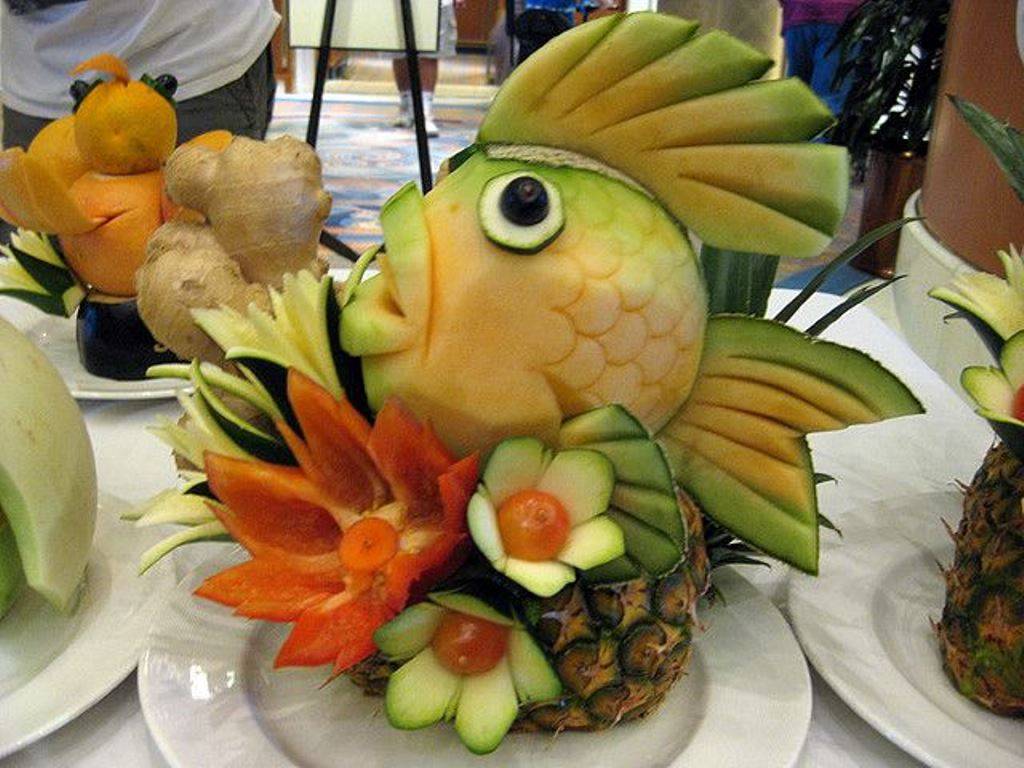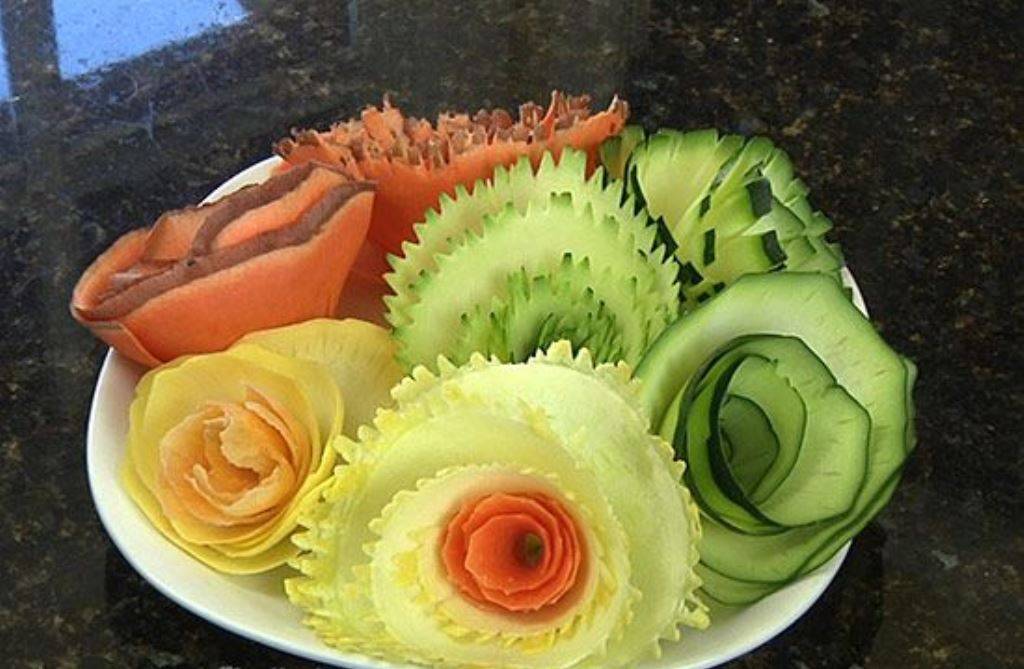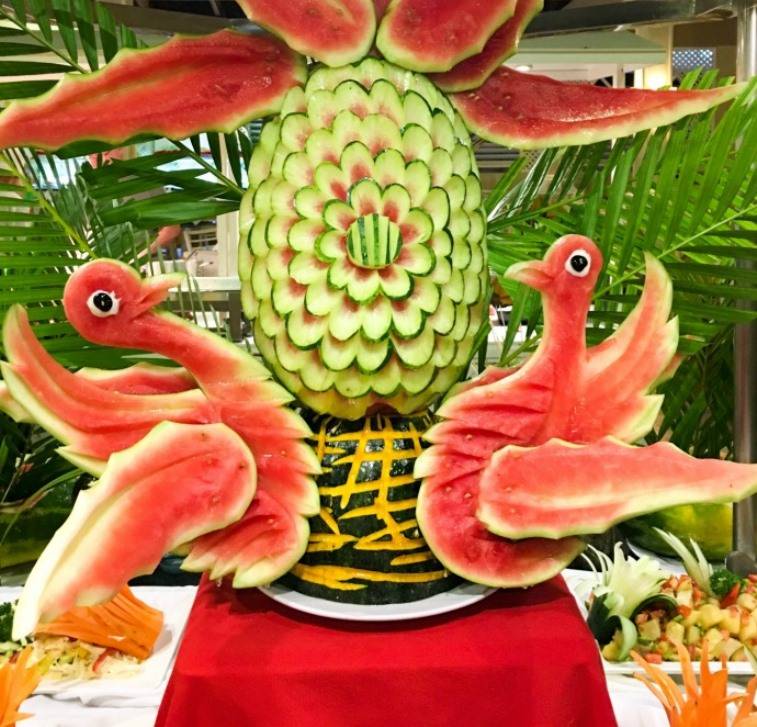
Carving art on the fruits and vegetables has become the sign of attraction for the guests attending the parties. There is a an attractive caricatures made out of fruits and vegetables near the plates lying for the gusts to go for the dinner for the food of the choice.
In Indian parties as well as the world over the chef always try to impress the guests by their skill of the art carving on the fruits and vegetables apart from the dishes they are preparing.
Fruit carving is the art of carving fruit, a very common technique in Europe and Asian countries, and particularly popular in Thailand, China and Japan. There are many fruits that can be used in this process; the most popular ones that artists use are watermelons, apples, strawberries, pineapples, and cantaloupes.
In Japan, the art is known as MUKIMONO and there are different names in the different countries.
Japan has a rich tradition of food carving called makimono. If you’ve ever eaten at a fancy restaurant in Japan you might have found a carrot carved into a bunny, garnishing your plate. But in the hands of Japanese artist Gaku, the art of fruit and vegetable carving is elevated to a new realm of edible creations.
One constraint to carving fruits and vegetables is that sometimes you must work fast. The moment a peel is removed, oxidization will start to discolor your artwork. So, depending on the variety, Gaku’s carvings are probably created within several minutes. Armed with a tool similar to an x-acto knife and a fruit or vegetable from the grocery store, Gaku carves intricate patterns that are often inspired by traditional Japanese motifs.

Gaku points out that the banana is great fruit to practice with because it’s cheap and easy to carve. When asked what he does with all his creations after he’s done, his reply is simple: he eats them. “Except for the banana peel.”
In America, Parker and Duey's winning sculpture, "Treasures Lost, Paradise Found," towered over six feet tall. The immaculate sculpture portrayed the bottom of the sea with a treasure chest and shipwrecked vessel on shore. Thai carved melons were stacked high and a sun sculpture sat on top. On the backside, a working waterfall cascaded down and there were tropical birds, a papaya snake and various tropical flowers, made of candy cane beets, rutabagas, turnips, chili peppers and rhubarb. "Once the clock expired there was a temporary sigh of relief, but the real sense of finality was when they declared the winner," Duey says.
Duey, a certified executive chef and member of ACF California Capital Chefs Association, has spent the last two decades developing his skill and creating fruit-and-vegetable carvings for weddings, events, classes and seminars. In 2004, he opened Chef Ray Presents, where he teaches the specialized art form to a wide variety of professionals across the United States. Duey has received numerous awards in national and international competitions. In addition, he is also corporate executive chef at Buffet Euro, San Francisco, Calif. For more information visit, www.chefgarnish.com.
"The Rematch: Fantasy Fruit Sculpture" Food Network Challenge is now airing on the Food Network. Visit www.foodnetwork.com for air times.
The American Culinary Federation, Inc., established in 1929, is the premier professional organization for culinarians in North America. With 20,000 members spanning more than 230 chapters nationwide, ACF is the culinary leader in offering educational resources, training, apprenticeship, and accreditation. In addition, ACF operates the most comprehensive certification program for chefs in the United States.

ACF is home to ACF Culinary Team USA, the official representative for the United States in major international culinary competitions, and also holds the presidium for the World Association of Chefs Societies, the largest international network of chef associations with more than 8 million members globally. For more information, please visit www.acfchefs.org.
In China, Many believe that fruit carving originated in China during the Tang Dynasty, which lasted from AD 618-906. Fruit carving in China usually features mythological creatures and animals. Not only is fruit carving used in cultural and traditional ceremonies, but also ordinary households are known for decorating plates with fruit carvings when they have guests over. Specifically, watermelon carving has been and still is very popular in China. Usually, the outside of the melon is carved on and the melon pulp is scraped out of the inside of the melon, so it can be used as a container to put food or flowers in. Chinese fruit carving is used to tell their legends and stories.
In Europe, Fruit carving is included in Matthias Giegher's 1621 work Il Trinciante ("The Carver"), where he describes carving oranges and citrons into abstract patterns, shell-fish, four-legged animals, and the Hapsburgs' double-headed eagle, but the art was not common in Europe or North America until the 1980s when several books on the topic were published.
In Thailand, Fruit carving is a significant part of Thai cultural heritage. Watermelon carving dates to the 14th century in Thailand during the Sukhothai dynasty. The annual Loi Krathong Festival occurs each November where people in Thailand float lamps and lanterns down a river to honor water spirits. One legend is that one of the king’s maids decorated her lantern with a watermelon carved with flower designs to impress him and that he was so pleased that he encouraged all Thai women to adopt the practice. The king also requested that fruit carving become part of the primary school curriculum. Thailand fruit carving features flowers, birds and floral patterns.
Some people perform fruit carving professionally. Some chefs utilize fruit carving as a culinary technique. Once fruit carvers have mastered the techniques past the intermediate stage and become professionals, they can price their services to restaurants, professional caterers, hotels and resorts. Professional fruit carvers can also create centerpieces and displays for various events, such as parties and wedding receptions. On a smaller scale, fruit carvers can present a dish with decorative garnishing to add an aesthetically pleasing experience to their viewers.
















